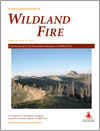
International Journal of Wildland Fire
Volume 25 Number 12 2016
WF16025Area burned in alpine treeline ecotones reflects region-wide trends
We analysed wildfires from 1984 to 2012 in eight mountainous ecoregions to determine if recent climate-driven increases in burning extended to alpine treeline ecotones. Little alpine vegetation burned, but in four of eight regions, the proportion of area burned in subalpine parkland was similar to or greater than that in the larger landscape.
WF16050Historical reconstructions of California wildfires vary by data source
A comparison of historical wildfire records in California shows large differences between written and spatial data sources, especially in data completeness. Smaller discrepancies in annual area burned result in cumulatively large differences over time. Different datasets reflect different strengths and weaknesses and these should be considered in any historical analysis.
WF16003Fire spread from MODIS burned area data: obtaining fire dynamics information for every single fire
A new strategy to derive detailed fire spread information from satellite imagery across large areas is proposed. Single fires are identified and described with respect to the timing and location of their ignition. The daily directional spread information of the fire events is also recorded during this process.
WF16070Curvature effects in the dynamic propagation of wildfires
Complex interactions between the environment and heat transfer processes can dynamically change the way a fire propagates. In this paper, we parametrise these effects using fire line curvature. Using curvature in a dynamic computational model shows a closer match to experimental fires than models without a curvature parameter.
WF15218Dead organic matter and the dynamics of carbon and greenhouse gas emissions in frequently burnt savannas
An integrated approach was developed to quantify changes in both dead organic matter and emissions of nitrous oxide and methane with changes in fire regime. A case study in tropical savannas of northern Australia indicated that altered fire management increased carbon stock by more than 3 times the carbon dioxide equivalent change in emissions.
WF16052Relationships between fire severity and recruitment in arid grassland dominated by the obligate-seeding soft spinifex (Triodia pungens)
Relationships between fire severity and plant recruitment processes in arid zone biomes are poorly understood. We examined recruitment following high- and low-severity fires in arid grassland dominated by the obligate-seeding Triodia pungens (soft spinifex), and found variable responses among species. Our results indicate that modelling plant responses to fire severity requires species-specific information on traits such as germination biologies, seedbank processes and lethal temperature thresholds of seeds.
WF16085Seed tolerance to heating is better predicted by seed dormancy than by habitat type in Neotropical savanna grasses
We investigated whether seed tolerance to high temperatures was related to dormancy type and habitat type for grass species from Brazilian fire-prone savannas. We found that seeds from wetter habitats had low tolerance whereas dormant seeds had high tolerance to heat shock, suggesting both dormancy level and habitat moisture contribute to the evolution of seed tolerance to heat.
WF16105Recently but infrequently burnt breeding sites are favoured by threatened Gouldian finches (Erythrura gouldiae)
Changed fire regimes, with larger and more frequent fires, are a potential cause of Gouldian finch population declines. Gouldian finches chose infrequently burnt breeding sites that were burnt in the previous fire season. Patchy grass seed availability, caused by frequent landscape fires, may influence finch decline.
WF15204Fire severity alters spatio–temporal movements and habitat utilisation by an arboreal marsupial, the mountain brushtail possum (Trichosurus cunninghami)
Large wildfires which burn uniformly may have a greater impact on fauna than fires which generate diverse patterns of burnt and unburnt habitat. We found that possum movement behaviour varied between landscapes which were burnt more evenly than those with diverse burn patterns. The spatial patterns of habitat created by large destructive wildfires can alter the behaviour and ecological relationships of fauna in forest ecosystems.



